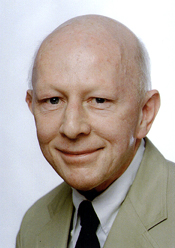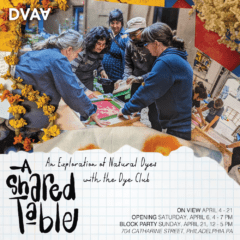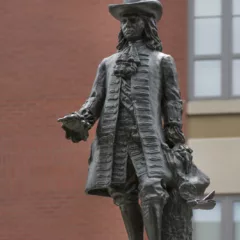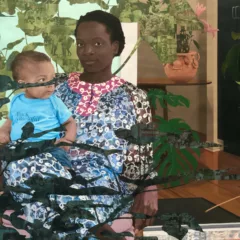The plane to Chicago for the College Art Association (CAA) Annual Meeting left from a concourse I rarely use so I saw different art than usual as part of the airport’s Exhibition Program, which certainly provides the best distraction I’ve found at Philadelphia International Airport. Nick Kripal’s Swarm was a terra cotta landscape of an alternative, multi-culti character with forms cribbed from the kitchen cabinets; what looked like a Moorish dome turned out to have been cast from a pudding mold! I’d love to see him do animations based on them.
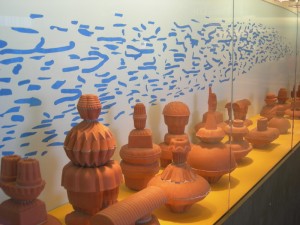
Flying to the CAA meeting after big snow and just before another meant delays, so I was happy to have Jenelle Porter’s catalog to Dance with Camera (ISBN 978-0-88454-118-9) for airport reading. She gives a particularly clear idea of the development of film technology, the background in Hollywood musicals and the influence of John Cage’s ideas on the form she calls dance with camera (or cine-dance): dancing choreographed to be filmed, rather than films of dances choreographed for the stage.
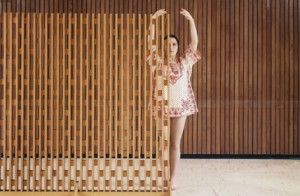
Porter also describes succinctly the circumstances of each of the films’ creation, something not always obvious to the viewer. I’d have liked more analysis, but then it might have been a textbook rather than a catalog, and she did re-print a number of important earlier essays (by Edwin Denby, Yvonne Rainer and Arlene Croce, among others) and interviews with Charles Atlas, Sharon Lockart and Shirley Clarke, all of which discuss ideas around the films. The well-illustrated catalog also includes a bibliography.
The exhibition, Dance with Camera, continues through March 21 at the Institute of Contemporary Art, and the catalog will certainly send me back (for the 4th time) to see films I missed and re-view some I saw. I love dance in any form: live, filmed or music videos (twenty years ago I presented a program on the art of music video), and have seen almost all the Hollywood musicals to which Porter alludes and some of the films and/or dancers; but even for the less dance-inclined viewer the exhibition will be in turns fascinating, funny, challenging, exhilarating, and provocative.
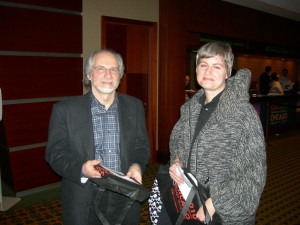
Any national meeting held in February is asking for weather problems somewhere, but this year was surprisingly bad with massive delays from most of the East Coast. I ran into Janelle Porter (author of the catalog I’d just read) and Michael Leja (Penn), who had just arrived when I saw him Thursday afternoon (missing a full day). Still, the conference was well- attended and participants seemed happy with the events.
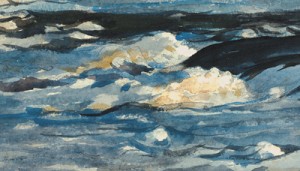
Full disclosure: I’m on CAA’s board – which, as I told all who asked, meant I was there to answer questions, field suggestions or complaints and be helpful; it also meant that I spent too much of the conference in meetings. But one of the highlights for me was a workshop, sponsored by the American Institute of Conservation and held in the Print and Drawings Study room of the Art Institute of Chicago (AIC). Curator Martha Tedeschi and conservator Kristi Dahm had a dozen Winslow Homer watercolors laid out for the group of thirty artists, art historians and curators who attended – we were able to examine them without glass! Tedesci and Dahm explained that their investigations of Homer’s virtuosic technique was prompted by the many artists who visited and would ask Tedeschi how Homer achieved those effects. I reviewed the catalog of the exhibition they organized here ; the AIC has a website which allows users to examine their research and “correct” the colors on watercolors which have faded.
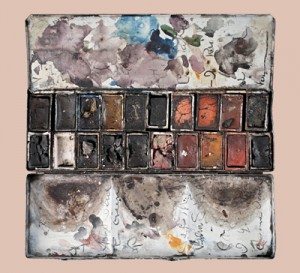
The book and trade fair is always an indication of trends in the field. Two new journals on graphic novels and comics are forthcoming: Studies in Comics and Journal of Graphic Novels and Comics; someone thinks the need is great!
There was also an evident interest in artists’ studios despite many years’ discussion of post-studio practice. I saw a number of books on the subject (one of which I reviewed here ) and two exhibitions on the subject were in Chicago: Production Site: The Artist’s Studio Inside Out at the Museum of Contemporary Art, which I missed, and Picturing the Studio at the School of the Art Institute of Chicago (SAIC), which was smart, lively and varied (from self-reflective to humorous, videos to installations, and artists from Rodney Graham and Bruce Nauman to Ivan Brunetti and Amy Sillman); sorry I didn’t have more time. It was partially supported by CAA. and was the site for a festive reception which I attended Friday night.
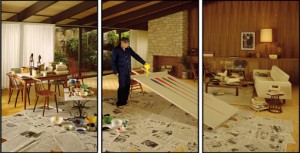
Three young artists were manning a booth for a nation-wide, participatory project Threadless; they run competitions for tee shirt designs and the winners (voted on by 900,000 on-line members) are printed and available on the site. Some illustration and graphics design teachers use the competitions as class projects, so they have a pedagogic aspect as well as a populist one. When they told me of an upcoming museum exhibition of their tee-shirts I mentioned Philadelphia artists’ active interest in screen-printing and suggested they look for a venue here. The booth also showcased a zine they produce, Faesthetic, which can be seen on their website.
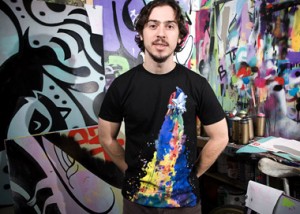
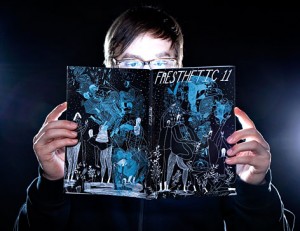
The CAA annual conferences have recently seen increasing organized activity among the younger artists and scholars. The Students’ and Young Professionals’ Committee had a lounge with wi-fi where they met and organized a series of practical exercises in job interviewing, resume-writing and associated professional skills. Jobs were scarce, but they were making good use of their time to network. Seeing colleagues has always been the major reason I attend the meetings. I’d met Barkley Hendricks at the recent symposium connected with his exhibition at PAFA, and saw him intermittently at the Art Institute, looking at paintings, and at the conference, where he was awarded a prize.
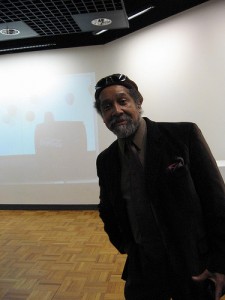
New York Times critic, Holland Cotter, was also at the conference where he won the Distinguished Lifetime Achievement Award for Writing on Art. He amused the convocation audience when he said the award surprised him since it implied that he had a life; he told us he writes and re-writes slowly and painstakingly, which means he works all the time.
